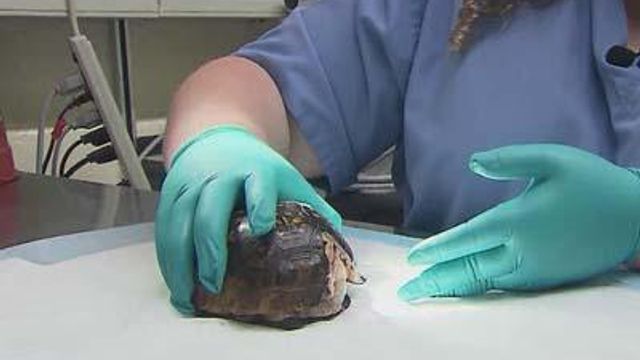Turtle rescue group seeing record number of injuries, hatchlings
Thanks to a warm winter and turtles being on the move earlier than normal, the nonprofit Turtle Rescue Team, a volunteer group run by veterinary students at North Carolina State University, is on pace to have a record-breaking year.
Posted — UpdatedThrough Friday, the group has taken in 218 turtles, frogs or snakes, about half of which end up being saved, nursed back to health and released into the wild. Most turtles that come in have been chewed on by dogs or hit by cars.
Turtles that have pieces missing from their shells are of particular concern.
"The part of the shell that is missing will not grow back, but it'll harden into a callus," volunteer Adrienne Breaux said of the injury suffered by Flotsam, a recently admitted box turtle. "It's not as hard as a shell, but it's protective enough that she will be OK."
National turtle expert Greg Lewbart, who has been the team's advisor since it started in 1996, said he expects a record year of both injuries and innovation from a group that often has to invent ways to help turtles heal.
"A lot of (the treatments) you can't look up because it's not in the textbooks," Lewbart said. "Some of it is, but a lot of it isn't. Our students are really pioneers."
Turtles are in decline overall, Lewbart said. Even the common box turtle can live for more than a century. But many are injured because turtles are creatures of habit and don't adapt well to unfriendly environments or changes to their surroundings.
"They go from their little pond or their spot in the woods to the place where they lay their eggs every year for 50 years, and all of a sudden there is a housing development or a road," he said. "There's a big impact on them."
Once turtles are treated for injuries, they are also nursed back to health. Just getting them to eat takes a lot of patience.
Breaux calls strawberries "turtle crack." "They like strawberries and tomatoes – anything red – even like bell peppers, or raspberries."
Although the increase in the number of injuries isn't something the group of 80 volunteers wants to see, the increase in turtles being kept in the center has also created a baby boom. Almost 100 turtles have already hatched, almost 70 more than the team's previous high mark for a single year.
Many turtles who are hit by cars are females searching for a place to lay their eggs. Some actually dig their nests in the loose gravel of elevated road shoulders.
The team does its best to salvage every egg, even when the mother doesn't survive.
"What we can do for them, even if we can't save them, is to continue their genetic line," Breaux said. "That's probably the most important thing we can do for them."
Most eggs are ready to hatch after about 60 days inside a makeshift incubator - a large cooler in the team's tiny office. They had to buy an extra cooler this year for all the eggs.
"We check the incubator twice a day and it's literally like Christmas twice a day," Breaux said. "It's awesome."
Once the baby turtles are ready, they'll be released into the wild. "We go ahead and release them where the mom was found," Breaux said. "And they really have to be as close to that as possible because they will try to go back there."
• Credits
Copyright 2024 by Capitol Broadcasting Company. All rights reserved. This material may not be published, broadcast, rewritten or redistributed.






